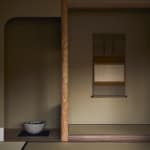Ryōkan (1758–1831)
Poems
Ink on paper, hanging scroll
With box authentication and titled by Yasuda Yukihiko
28 x 50 cm
105 x 53 cm (overall)
With box authentication and titled by Yasuda Yukihiko
28 x 50 cm
105 x 53 cm (overall)
Further images
Provenance
Collection of Yasuda YukihikoLiterature
Ryokan no sho: Yasuda Yukihiko no aizohin ni yoru. Tokyo: Chuo Koron Bijutsu Shuppan, 1985.
This work begins with three haiku poems on the theme of autumn. There are also four waka poems, including an ode to bush clover, a poem to Oyoshi, a lady of the Yamada-ya in Yoita Town, and a poem written on the fortieth birthday of Yoshinari, the head priest of Honko-ji Temple. These are joined by a Chinese poem extolling Matsuo Basho. Finally, the writer has also penned a playful verse about his habit of turning up, without pen or paper, to write at temples or at the houses of physicians and so on. This superlative work is a distillation of Ryokan’s charms, from his reverence for nature to his relations with the townsfolk and his cheerfulness amid the tribulations of a life of honorable poverty.
Ryokan’s fondness for Basho is on clear display in his poem lauding the great master. Ryokan’s father Yamamoto Inan (1736–1795) was so adept at haikai (a poetry form associated with Basho) that people called him the “leader of the Basho revival in the Hokuriku region.” Ryokan also penned over a hundred haiku poems himself. One of Basho’s poems was written during his stay in Izumozaki during his travels around Japan, as recounted in The Narrow Road to the Deep North. Ryokan was born in Izumozaki, so perhaps his reverence for Basho was intermingled with a sense of affinity for his literary predecessor.
A sign of Ryokan’s fervent veneration for Basho is perhaps seen in the crossed-out section at the start of the Chinese poem extolling Basho. In his eagerness to start writing, it seems Ryokan accidentally scribbled “Basho” itself rather the great master’s honorific title, as he had originally intended. The calligraphy also radiates a charming sense of familiarity. This work once belonged to Yasuda Yukihiko (1884–1978), a Japanese painter and a keen admirer of Ryokan. The beautiful variations in ink shading and touch are typical of Ryokan’s late works.
Ryokan (Zen priest, poet; 1758−1831)
Echigo-born late Edo period Zen priest and poet. Became a disciple of Genjo at Kosho-ji Temple, and was given the Buddhist name “Taigu Ryokan.” Also studied under Kokusen at Entsu-ji Temple in Tamashima, Bicchu. Later traveled to numerous provinces in over twenty years, and led a free life that is full of anecdotes about his eccentric behaviors. His waka (Japanese-style poetry) composition in the style of Man’yo-shu and his calligraphy manner are so well balanced that it is highly praised.
Ryokan’s fondness for Basho is on clear display in his poem lauding the great master. Ryokan’s father Yamamoto Inan (1736–1795) was so adept at haikai (a poetry form associated with Basho) that people called him the “leader of the Basho revival in the Hokuriku region.” Ryokan also penned over a hundred haiku poems himself. One of Basho’s poems was written during his stay in Izumozaki during his travels around Japan, as recounted in The Narrow Road to the Deep North. Ryokan was born in Izumozaki, so perhaps his reverence for Basho was intermingled with a sense of affinity for his literary predecessor.
A sign of Ryokan’s fervent veneration for Basho is perhaps seen in the crossed-out section at the start of the Chinese poem extolling Basho. In his eagerness to start writing, it seems Ryokan accidentally scribbled “Basho” itself rather the great master’s honorific title, as he had originally intended. The calligraphy also radiates a charming sense of familiarity. This work once belonged to Yasuda Yukihiko (1884–1978), a Japanese painter and a keen admirer of Ryokan. The beautiful variations in ink shading and touch are typical of Ryokan’s late works.
Ryokan (Zen priest, poet; 1758−1831)
Echigo-born late Edo period Zen priest and poet. Became a disciple of Genjo at Kosho-ji Temple, and was given the Buddhist name “Taigu Ryokan.” Also studied under Kokusen at Entsu-ji Temple in Tamashima, Bicchu. Later traveled to numerous provinces in over twenty years, and led a free life that is full of anecdotes about his eccentric behaviors. His waka (Japanese-style poetry) composition in the style of Man’yo-shu and his calligraphy manner are so well balanced that it is highly praised.







